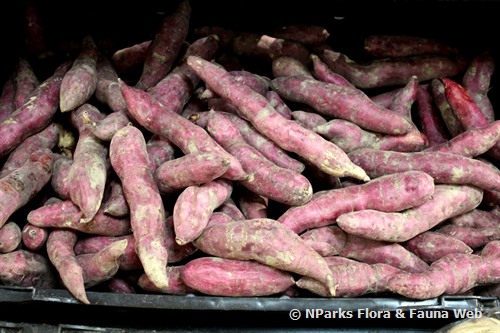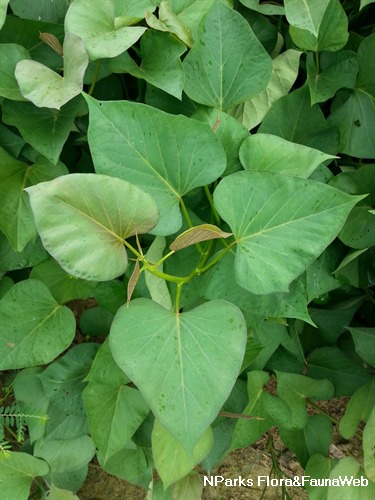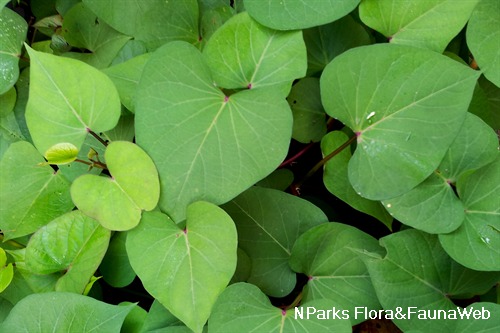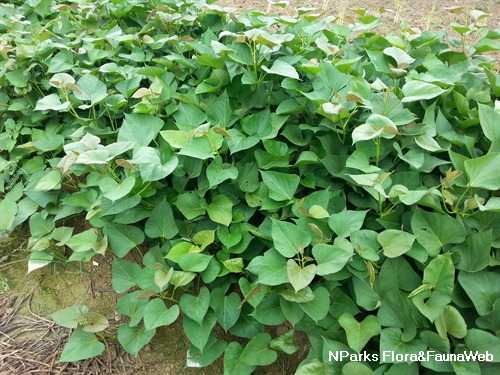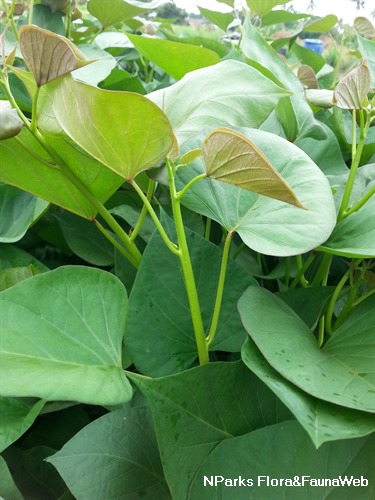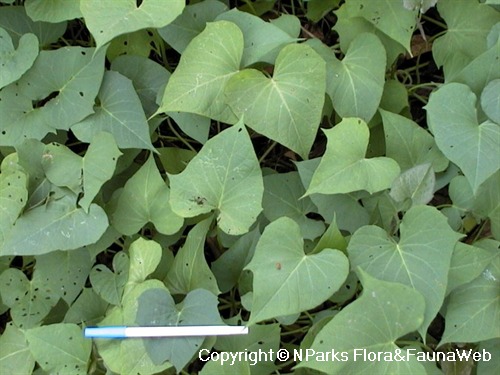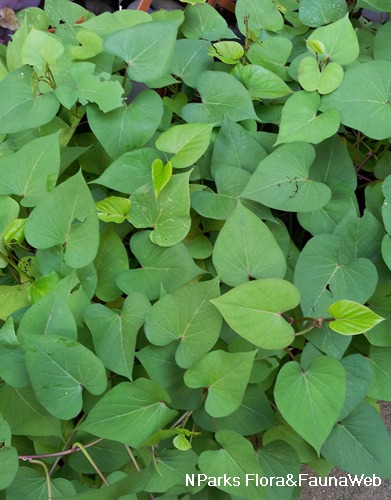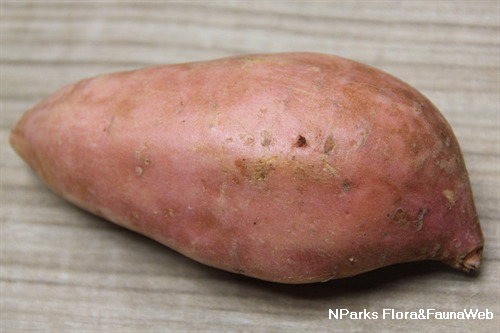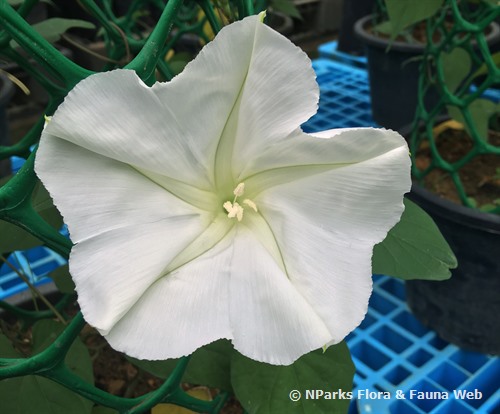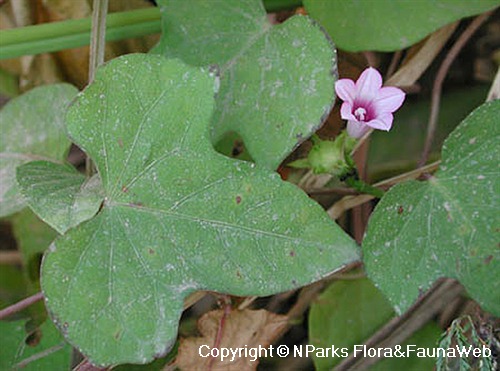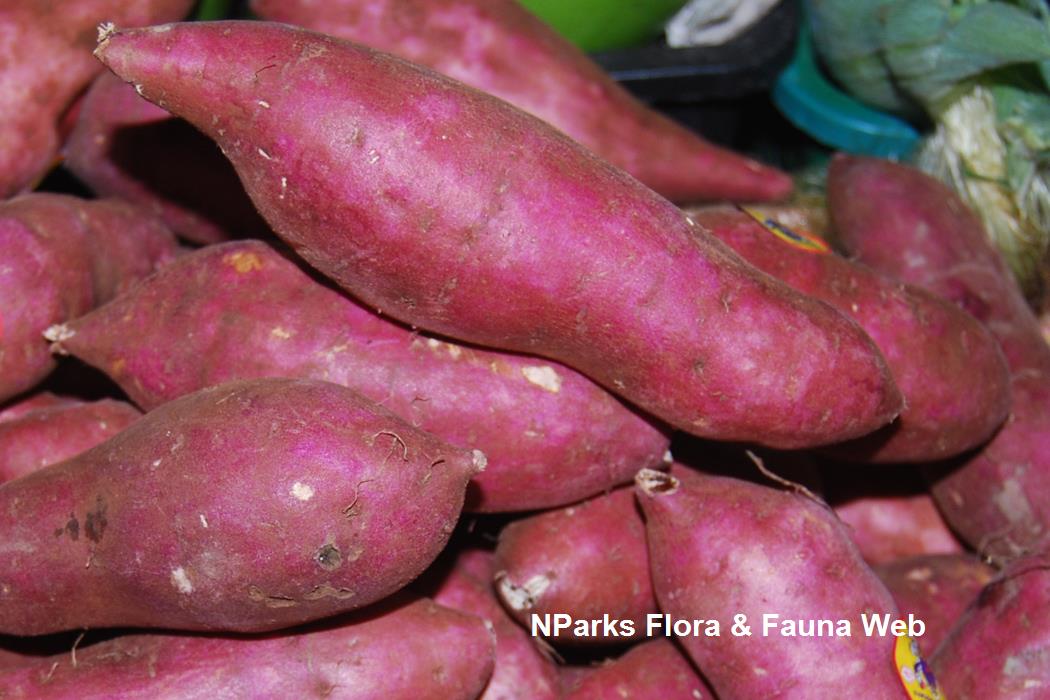
Back
Ipomoea batatas (L.) Lam.
| Family Name: | Convolvulaceae |
| Synonyms: | Aniseia edulis, Batatas edulis, Aniseia batatas |
| Common Name: | Sweet Potato, Keledek, 番薯 |
Sweet Potato is a fast-growing vine that produces edible, nutritious tubers in about 2 months in the tropics or 3-4 months in subtropical or temperate climates. The leaves and shoots are also nutritious and often stir-fried or added to salads.
Name
Classifications and Characteristics
| Plant Division | Angiosperms (Flowering Seed Plants) (Dicotyledon) |
|---|---|
| Plant Growth Form | Climber, Creeper |
| Lifespan (in Singapore) | Perennial |
| Mode of Nutrition | Autotrophic |
Biogeography
| Native Distribution | Tropical America |
|---|---|
| Preferred Climate Zone | Tropical, Sub-Tropical / Monsoonal, Temperate |
Description and Ethnobotany
| Growth Form | Perennial vine with a creeping habit. |
|---|---|
| Roots | The root system of I. batatas is fibrous with adventitious roots, some of which undergo secondary thickening to form enlarged tuberous roots, which serve as storage organs. These storage roots, what we commonly know as sweet potatoes, are variable in shape, size, number, skin colour, ranging from white to yellow to brown to orange and purple, and flesh colour, including white, yellow, orange and purple. |
| Foliage | Leaves green, with some varieties having yellowish or purplish leaves. Leaf shape ranges from ovate-cordate to palmate depending on the variety. Leaves are spirally arranged on stems and borne on long petioles. Leaf margin entire or palmately lobed. |
| Stems | Stems prostrate or ascending, slender and occasionally twining, up to 4 m long, and producing a milky juice. Many lateral stems arise from each main stem. |
| Flowers | Flowers white or purplish, funnel-shaped and axillary, borne singly or in inflorescences, known as cymes (= flat-topped inflorescences with central flowers that open first). |
| Fruit | Fruit a 5-8 mm long capsule containing 1-4 seeds, which are black with very hard seed coats. |
| Cultivation | Sun-loving, although tolerant of semi-shade conditions, and water-loving, with growth impaired by low water supply. However, I. batatas is also drought-tolerant for short periods. I. batatas can grown on a wide range of soils, including moderately deep, very friable fine sandy loams, sandy loams, or loamy fine sands. A well-drained sandy loam with a clayey subsoil is considered ideal. Intolerant of waterlogging. Gentle slopes are preferred, with little tendency for erosion. I. batatas competes poorly with weeds, the latter reducing crop yields and interfering with harvesting. Propagation of I. batatas may be carried out vegetatively from stem cuttings or using sprouts obtained from cuttings of storage roots. Propagation by seed is also possible, but usually only for breeding purposes. From sowing to harvest, it takes 120 days or more. |
| Etymology | The genus name, Ipomoea, is Greek for "worm-resembling", referring to the sinuous twining stems of the plant, while the specific epithet, batatas, is derived from the Haitian name, batata, for sweet potato. |
| Ethnobotanical Uses | Edible Plant Parts : Edible Leaves, Edible Storage Organs Food (Fruit or Vegetable): In Singapore, as well as other parts of Southeast Asia, tender leaves are stir-fried with sambal belacan (spicy shrimp paste). The tubers are also boiled to make a sweet soup, fried to make French fries and stewed to make porridge. Others: Food: I. batatas is mainly cultivated for its storage roots, which are consumed mainly as a vegetable in tropical countries. The tubers may be eaten in numerous ways, such as boiled, baked, fried, made into flour for biscuits, bread and pastries, dehydrated to make chips or creamed for use in desserts. In Papua New Guinea and some countries in Oceania, I. batatas roots are a staple food. The tender leaves and young shoots of I. batatas, which are rich in vitamins, minerals and proteins, are also eaten as a green vegetables. Medicine: A decoction of the leaves of I. batatas are known to be used in folk remedies for tumors of the mouth and throat. The plant is also used for other ailments, including asthma, fever and nausea. Other Uses: Small portions of I. batatas crops are used as feed or for industrial purposes, including starch and alcohol production. |
Landscaping Features
| Desirable Plant Features | Ornamental Foliage |
|---|---|
| Landscape Uses | Container Planting |
| Usage Hazard - Cons Remarks | Roots may contain the laxative, ipomoein. |
Plant Care and Propagation
| Light Preference | Full Sun |
|---|---|
| Water Preference | Moderate Water |
| Plant Growth Rate | Fast to Moderate |
| Rootzone Tolerance | Fertile Loamy Soils, Well-Drained Soils, Drought Tolerant |
| Propagation Method | Seed, Stem Cutting, Root Cutting |
| Seed / Spore Germination Duration | 6 days to 15 days |
Foliar
| Mature Foliage Colour(s) | Green, Purple, Yellow / Golden |
|---|---|
| Foliar Type | Simple / Unifoliate |
| Foliar Arrangement Along Stem | Spiral |
| Foliar Shape(s) | Non-Palm Foliage (Ovate, Palmate, Cordate) |
| Foliar Venation | Palmate |
| Foliar Margin | Entire, Palmately Lobed |
| Leaf Area Index (LAI) for Green Plot Ratio | 4.5 (Shrub & Groundcover - Dicot) |
Non - Foliar and Storage
| Stem Type & Modification | Herbaceous |
|---|---|
| Root Type | Underground (Fibrous Root) |
| Specialised Storage Organ(s) | Underground (Root Tuber) |
Floral (Angiosperm)
| Flower Colour(s) | Purple, White |
|---|
Fruit, Seed and Spore
| Mature Fruit Colour(s) | Brown |
|---|---|
| Fruit Type | Dehiscent Dry Fruit , Capsule |
Image Repository
Others
| Master ID | 127 |
|---|---|
| Species ID | 1423 |
| Flora Disclaimer | The information in this website has been compiled from reliable sources, such as reference works on medicinal plants. It is not a substitute for medical advice or treatment and NParks does not purport to provide any medical advice. Readers should always consult his/her physician before using or consuming a plant for medicinal purposes. |

